13 February 2023
![]() 14 mins Read
14 mins Read
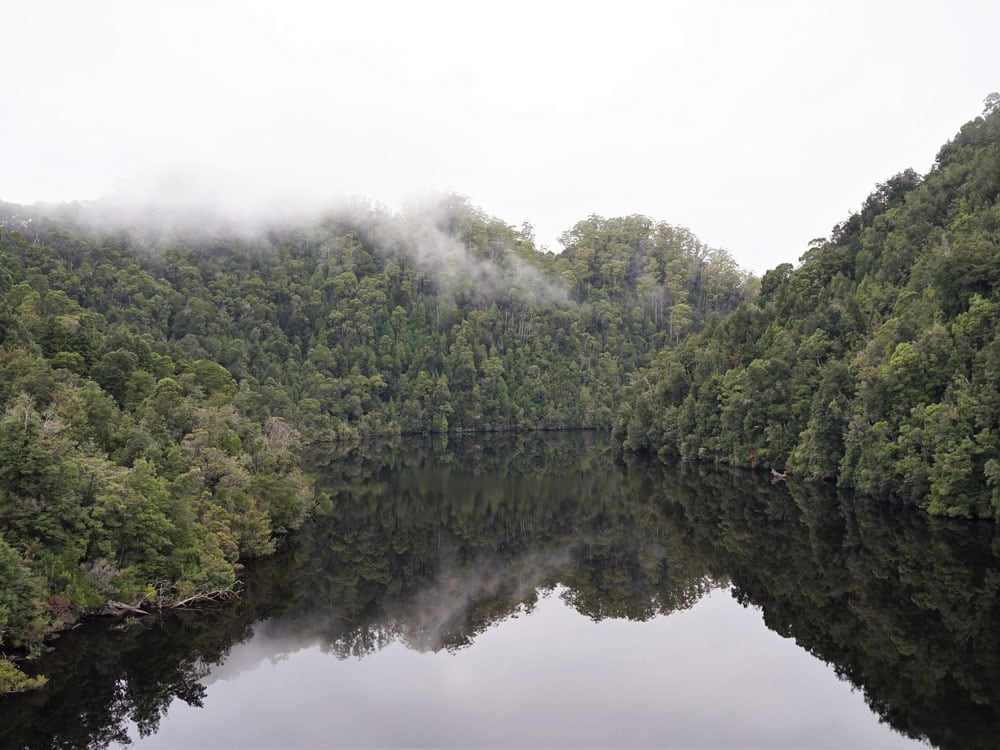
It is an ‘is’ and not a ‘was’ only because we vanquished its most profound threat. That threat, of course, was, and in some ways is, still us.
If you were born after the early 1980s, the Franklin River is probably an anonymous realm to you. Just one of the six national parks that entwine into the glorious nebulosity of the Tasmanian Wilderness World Heritage Area, where Australia’s wildest river apparently flows unhindered.
Yet back when folk wore acid-wash denim and rocked big hair, the 129-kilometre river was Kardashian-level famous, becoming a reluctant ground zero for Australia’s conservation movement. The Franklin’s lower reaches came within a Tassie tiger’s breath of being a drowned dystopian Atlantis.
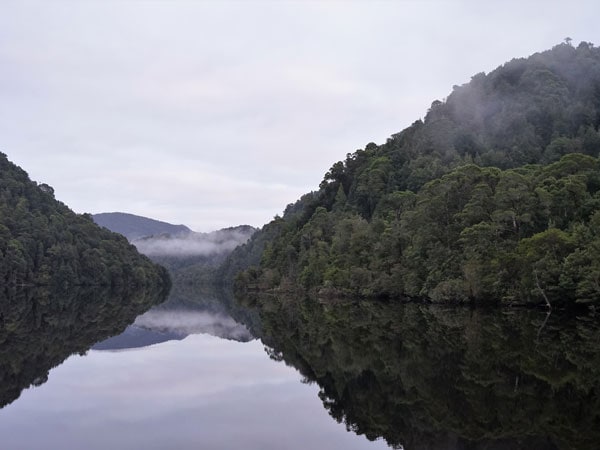
Today, the Franklin-Gordon Wild Rivers National Park flourishes. (Image: Steve Madgwick)
The state’s Liberal government had deployed heavy machinery to build the Gordon-below-Franklin hydro-electric scheme, promising dizzying progress and jobs that would flow when the river effectively ceased to. But famously, a fringe group of Boomers thought that a dam was a terrible idea and snapped back.
Marshalled by Bob Brown’s Tasmanian Wilderness Society, around 6000 protestors advanced on West Tassie, blockading the advancing heavy metal in a non-violent flotilla of piddling rubber duckies. Some 1300 were arrested, 500 jailed, but the stoush picked by these early-day environmentalists resonated Australia-wide.
Some say the former prime minister Bob Hawke’s Save-the-Franklin stance swayed the 1983 election for him, but it still took a close-won High Court decision to thwart the dam. It was the first time that modern Aussies collectively chose to pedestal mass biodiversity for its own sake – a precedent that later safeguarded places like the Daintree.
Today, the Franklin-Gordon Wild Rivers National Park flourishes in a way that yearly profit-and-loss statements do not yet capture. The river tells her own story now, ever so silently – inherently risky in these Adani-esque times, when out-of-sight often means easier to mine/dam/blow up.
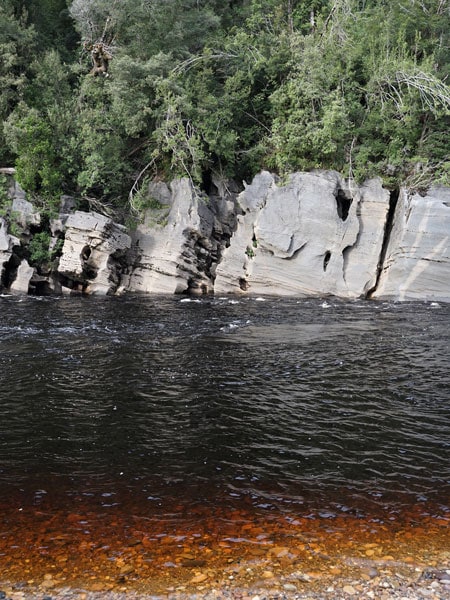
Image: Steve Madgwick
She’s not an easy place to get to know. Traversing a World Heritage area twice the size of the ACT garrisoned by chasmic gorges and ‘impenetrable’ forest comes with boatloads of barriers. No joy flights are allowed. The Franklin’s few walking tracks are for Bear Grylls and his mates. And you can only sip at the national park’s sublime, steep, sensual landscape from one road. Realistically, unless you’re a kayaking wunderkind, the only way to feel the Franklin’s life force is aboard a white-water rafting expedition. All aboard, then…
Below Collingwood Bridge, an odd-looking congregation tensely squeak into day ensembles – wetsuits, thermal tops and waterproof cagoules. We hand-pump three of Franklin River Rafting’s Day-Glo orange reinforced-PVC rafts; and lash barrels and eskies of sustenance and shelter to their frames. We stuff our moderately sized ‘dry bags’ with 10 days’ worth of warm-and-dry essentials.

Rafters debriefing at Sir John Falls on the Gordon River. (Image: Steve Madgwick)
Banjo-themed Deliverance jokes land uneasily, as we launch into the Collingwood bound for its Franklin confluence. The unremarkable bridge bends aloofly from sight and, with it, the ‘outside world’ flows away.
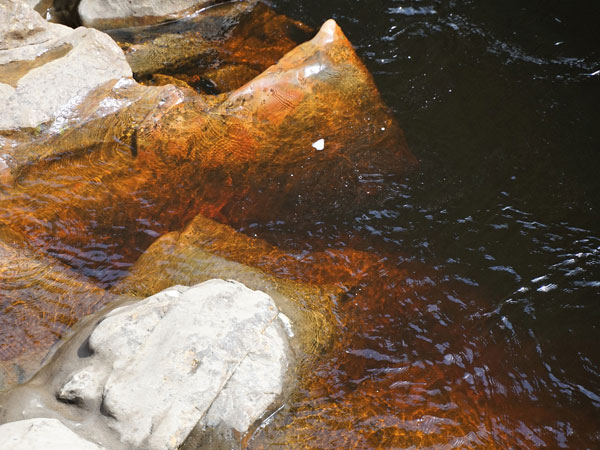
The waters of the Franklin River are tinted dark from tannins. (Image: Steve Madgwick)
Rain is omnipresent, like a passenger who refuses to paddle. It taps on our helmets by day, murmurs to us after dark, but also helps propel us and constantly replenishes our sole (untreated) drinking-water source. First sips from the river are tenuous because the modern world distrusts the natural world nowadays. In eddies, it is the colour of well-steeped tea, fizzing into SodaStream cola when stirred, hued by an infinity of tea-tree and buttongrass tannins. Its taste, however, is the very definition of neutral.
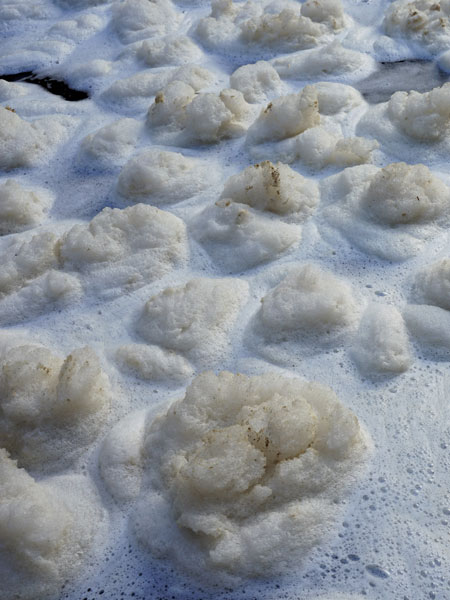
The water resembles a fizzing SodaStream cola when stirred.
The lead raft offers stall-seat perks. We surprise a platypus into a nifty tail flick. Cherry-blossom-like white leatherwood flower petals tendril into bewitching swirls. We drag and heave-ho ‘Wombat’ around snags and shallows until Collingwood’s chill nips through our wetsuit socks and classic canvas Dunlop Volleys.
Six hours later, the Franklin swallows its tributary without a burp. At water level, life gushes card-trick fast, but above is a foggy, shadowy slow-motion scene from an indistinct time; it could be 9000 BC or tomorrow evening for all we know. Southern sassafras, leatherwood, and myrtle greens mosh together up the hundred-metre-high valley. At the Loddon River junction, the endemic Huon pine adds its enigma; its females preferring precariously close river frontages.
‘Pristine’ and ‘untouched’ seem appropriate natural descriptors but they are deeply flawed. Huon ‘piners’ harvested here for generations. Convict Alexander Pearce busted the ‘impenetrable’ myth twice-over, reaching Hobart from the West Coast – admittedly, he had to eat five fellow escapees to do so. Even the dictionary definition of ‘wilderness’ doesn’t ring true, because we well know that Indigenous people inhabited parts of this supposedly ‘uninhabitable’ land.
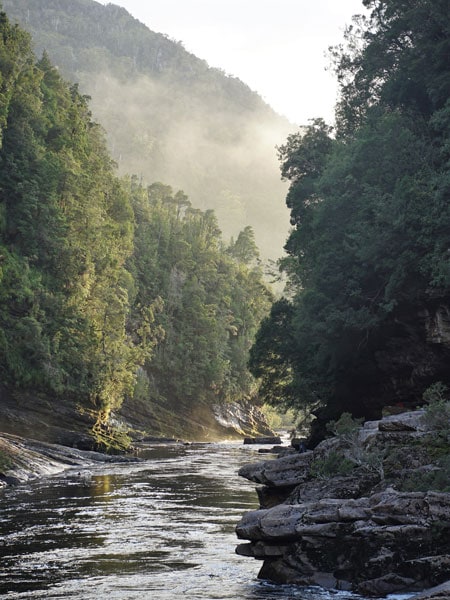
The Franklin River is also famous for its rock formations and caves. (Image: Steve Madgwick)
Today, the Save-the-Franklin legacy is still a big drawcard. Blockade veterans and/or their families come to search for memories; more often, it’s people from that generation who wish they could have blockaded.
“I went to a dam protest in Melbourne with my parents at 10 years old,” says guide Sean Murray, who has rafted this river more than 40 times. “At aged six, I remember reading ‘Gordon-below-Franklin dam’ and thinking the Gordon must be an underground river. I also clearly remember that iconic Rock Island Bend photo in The Age – we had that poster on our wall. When I first saw it for real, it was very surreal.”
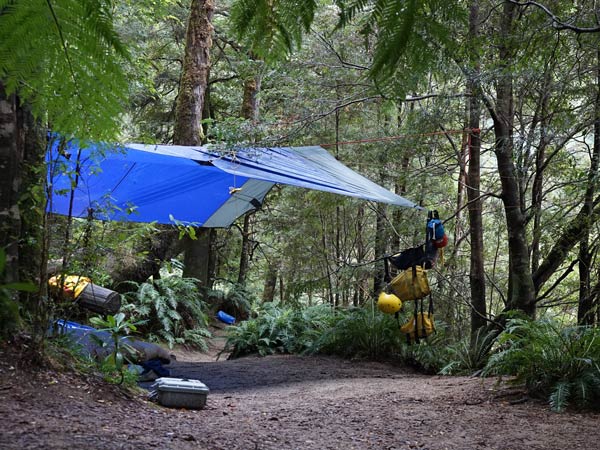
Camping amid river-side rainforest in the Upper Franklin. (Image: Steve Madgwick)
The nightly camp set-up is an all-hands-on-deck affair. We human-chain each raft’s cargo up boggy banks into caves, claim the flattest nooks available, then layer up into dry thermals and insulation (no fires allowed). After dark, the river hullabaloos a sonorous, unrelenting score into Angel Rain Cavern: thundery, almost industrial at times, occasionally punctuated, I swear, by a distant, disembodied voice. Enchilada-ed into my minus-rated sleeping bag, an imprecise, phosphorescent green glow illuminates my chosen hollow. The glow-worms’ working day begins as mine ends.
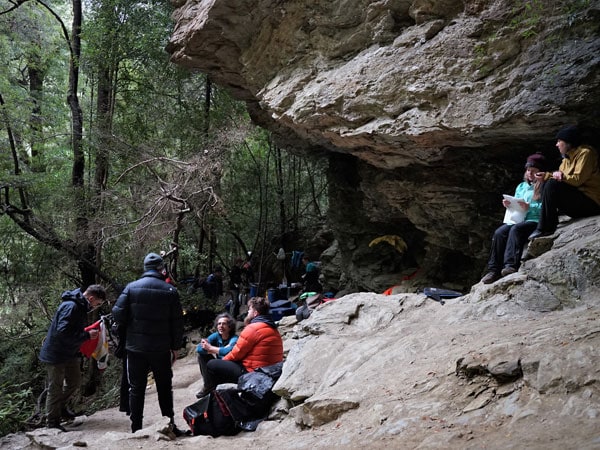
Six-star camping in the Angel Rain Cavern. (Image: Steve Madgwick)
“There’s some juice in the river today,” says Austrian-born guide Franzi Eichler, with storm-chaser-like fervour. This is her first expedition since having her daughter one year ago. Her partner (and Franklin River Rafting Company co-owner) Elias is taking his turn to wrangle their two kids. “I doubted my fitness, but I’ve worked really hard to get back,” she says. “It’s a super-physical job, but as soon as you get back on ‘the stick’, it’s like you’ve never left.”
Franzi concedes that raft-guiding has a ‘blokey’ reputation, but reckons it’s 100 per cent equal opportunity if you pull your weight. She smiles at the thought that her young ones will one day become part of this worldly community of professional river gypsies.
The Upper Franklin’s temper frays above Descension Gorge. “Over right,” bellows Sean, but the river hisses louder, spitting two paddlers out the low side. I helmet-butt my raft mate on the exit. Green kaleidoscopes with grey-sky snippets. Bubbly water flicks my face. The surge has me. Franzi’s words resonate: “Face downstream, legs up, so you don’t hit rocks.” Tick. “Hold onto your paddle.” Tick. “Don’t wee in the wetsuit.” Who me?
“Forward paddle,” roars Franzi, loudly enough to wake the kids in Hobart, mobilising her crew upstream. They scoop up my fellow flotsam in moments that seem like minutes. I panic swim out of the flux, bury my claws into a tea-tree-cum-life-preserver. Sean and my raft’s lone-remaining paddler are ready to receive me downstream.
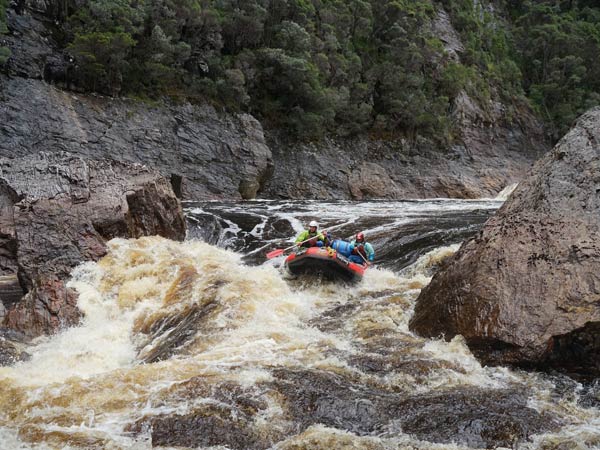
Experience the real-life drama of facing down the Great Ravine. (Image: Steve Madgwick)
Judging by Franzi, Sean and Ben’s insouciant faces, a multi-human rescue is almost a ho-hum chore for these shaman-like cyborgs. At times of high heartbeat, in a place with no easy exits, each guide must draw on their own remote-area experience. Sean, for example, was an outdoor-education lecturer for 16 years and remains a back-country ski guide in places like Kyrgyzstan and Svalbard. Hashtag trust.
Equally importantly, they have learned from those who went before them, no more dramatically chronicled than in the book Shooting the Franklin, a harrowing, mid-20th-century non-fiction tale of brave souls who smashed down the then-uncharted river in rudimentary canoes and woollen jumpers. (Spoiler alert: it took them more than one go.)
Descension Gorge’s drama relaxes into Irenabyss (‘Chasm of Peace’ in Greek). Many Franklin appellations were lyrically named by Bob Brown to paint an emotive picture of a faceless place. Make it sound like it was worth preserving. Over the years, loggers and kayakers chipped in, too. Helpfully, infamous rapids have idiot-proof warnings attached: Wild Thing, Nasty Notch, the Cauldron (which features in Richard Flanagan’s Death of a River Guide).
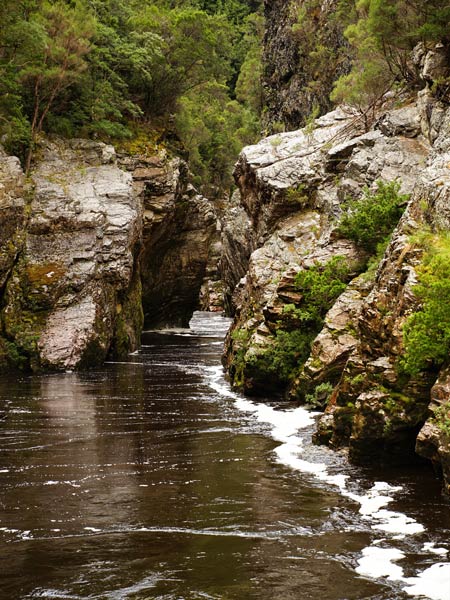
The peaceful Irenabyss. (Image: Steve Madgwick)
A thoroughly disapproving sky scuttles our plan to scale quartzite monolith Frenchman’s Cap from Irenabyss camp (eight hours’ gruelling hike). Pressing on, we ghost past an old helipad and flying fox at Fincham’s Crossing, once one of four proposed dam sites. Two wedgetail eagles shadow us from the biblically steep ridgetops of Jericho Walls. Exiting the ‘Crankle’, a waterlogged pademelon on the water’s edge tilts her head as if to say, “How ’bout this bloody rain?”
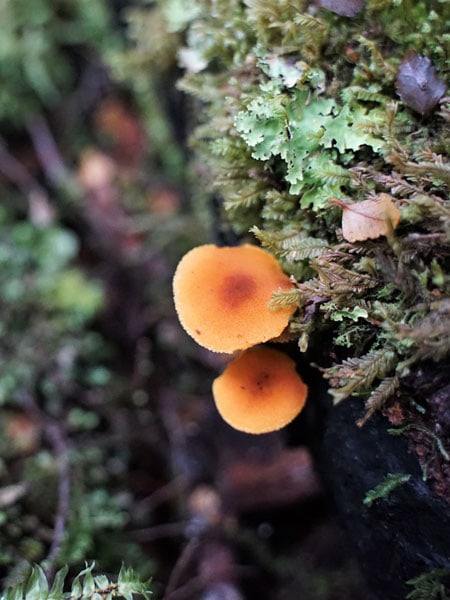
Bracket, polypore and woody fungi are abundant. (Image: Steve Madgwick)
We tarp up in sodden forest at Camp Arcade. Luminous orange mushrooms the size of halflings’ ears pop from the gloom. While we sleep, Franzi ties and re-ties the rafts to higher branches. The ‘ever-varying flood’, as an eponymous book describes it, surges two metres overnight, granting us an enforced rest day. “Never raft a rising river,” is Franzi’s refrain.

The reinforced rafts take max punishments with barely a squeak of complaint. (Image: Steve Madgwick)
A solitary currawong’s unanswered call pings bank to bank as we decamp, faced with Franklin’s Everest: the Great Ravine. Fixated, we flow through its imposingly narrow entrance, which Franzi likens to the Black Gates of Mordor. Make no mistake, the Great Ravine is no place for sightseers.
For the high-functioning professionals alongside me, it is a lesson in old-fashioned teamwork. The guides don’t want untimely shows of strength or initiative. Simple instructions are yelled crisply: “Paddle. Stop. Get down and hold on.” Technically, steering these “overloaded shopping trolleys” is only possible if we paddle faster than the flow. Bilateral trust is crucial, too. Appreciate that if you are careening towards a giant boulder, even backwards, it is part of the navigation plan.
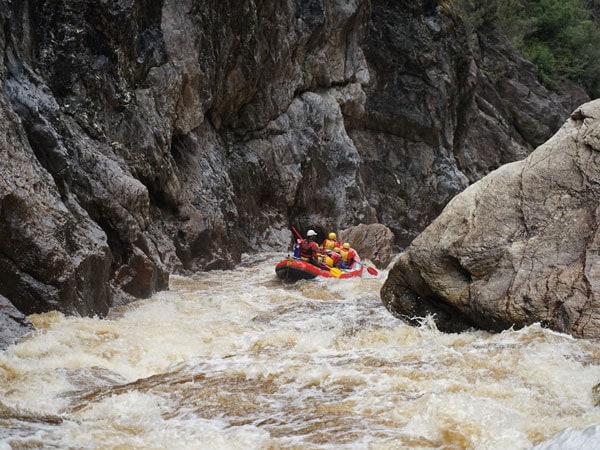
Franklin River Rafting guides negotiate a notorious rapid in the Great Ravine. (Image: Steve Madgwick)
For blind bend after blind bend, the Franklin’s full force squeezes through barely raft-wide tiered drop-offs. The Churn, Thunderush, and the Cauldron are white-water equivalents of a Carolina Reaper. We ‘portage’ notorious stretches that ‘boil’ rabidly. Life jackets and helmets firmly fastened, we scramble lynx-like over perilously slick rocks, clamber up bush-bashed trails, to our downstream rendezvous. Meanwhile, the guides ‘line’ ghost rafts down the spume, inch by inch.
A few-hundred-metre portage shaves hours from our day and sucks gas from our tanks, but these trouble spots have well-documented pasts. On the banks of Pig Pen, we stumble upon an engraved silver plaque nailed onto a tree; a modest memorial to an intrepid canoeist who died here in the ’80s. One of his expedition mates happens to be one of our expedition mates; it’s his first time back on the river. We ask no questions, but he drip-feeds the story as he gets to know us.
At Pig Pen’s exit, the 1980s poster child arises. Back then, photographer Peter Dombrovskis snapped Rock Island Bend in moody mist – a scintillating slow-shutter sortie against then Tasmanian premier Robin Gray’s infamously ridiculous dismissal of the Franklin as just a brown, leech-ridden ditch.
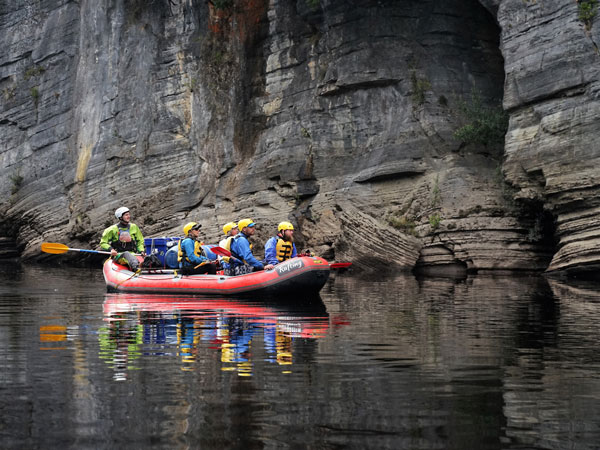
Exploring the calmer Lower Franklin. (Image: Steve Madgwick)
Here the river kicks off its Blundstones and wriggles into some Ugg boots and trackies. “The pressure is on until the end of the Great Ravine,” says Franzi. Today, halfway through, is the first time she’s looked at a photo of the kids. “The guides can take a deep breath now because the Lower Franklin is quite relaxing in comparison.”
Newland Cascades’ immense overhang is six-star cave-camping; a serene rest-day scene, where us wild things can roam, eat native currants, eyes wide for snakes.
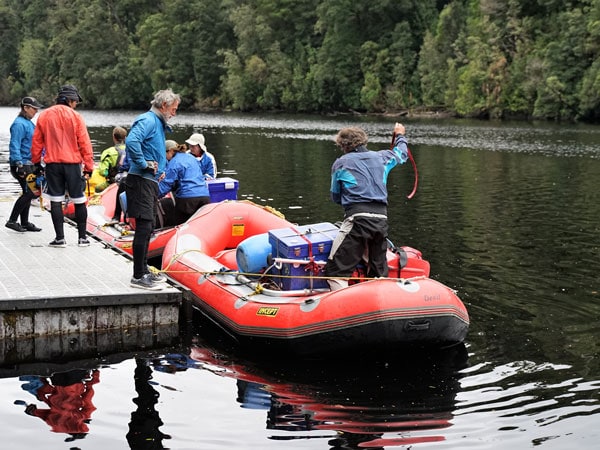
Rafters pulling into the jetty at Sir John Falls on the Gordon River. (Image: Steve Madgwick)
Finally, the sun squirms through the clouds, illuminating dollops of ice-creamy froth which settle cappuccino-like in camp-front eddies. We peel off over-ripe wetsuits to air, squeal as we jump in for a dip.
The aroma of camp-stove coffee levitates poignantly in this thoroughly rain-washed environment. After day naps, we nibble blue cheese, hummus and crackers, then gobble up heaped bowls of pasta magicked up by the dexterous guides-cum-cooks-cum-journeymen-and-women. The next day, at noon, we leave Newlands as we found it.
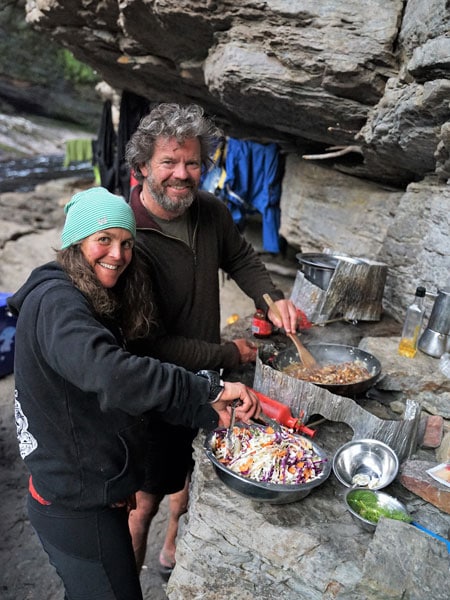
Franklin River Rafting co-founder Franzi Eichler and guide Sean Murray exceed expectations when it comes to their guiding and cooking abilities. (Image: Steve Madgwick)
“The words ‘no trace’ get thrown around a lot, but these trips really are no trace because you don’t even leave footprints,” says Sean. “There are no signs of human interference for most of the way downriver.”
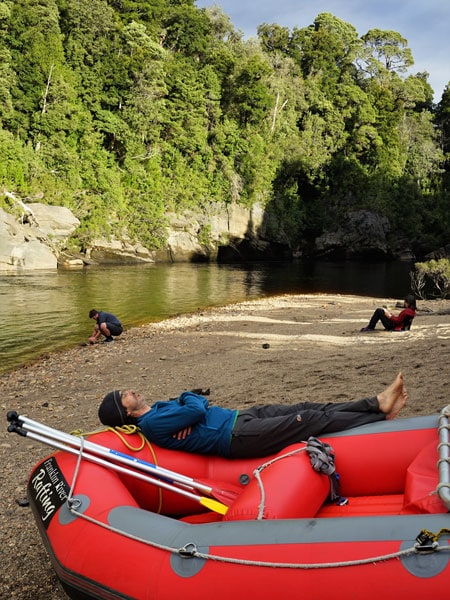
An afternoon’s kip on the Lower Franklin. (Image: Steve Madgwick)
Tree martins swoop at their reflections on wide, placid pools. Driftwood logs matchstick together on the banks. The Lower Franklin’s squat, tangly lowland rainforest is a dead-set Amazon doppelgänger.
“The great thing about coming back time after time is seeing the river in so many moods,” says Sean. “Seasonal changes can be subtle and stark. The way the myrtle changes colour, the way the waratahs and leatherwood flowers come out then disappear.”
We bumble out of our rafts through a dragon-sized rock gateway into the Lost World Canyon. Thigh-deep, we ford the dark, cold stream into a sun-shy crack between two dimensions. In the half light, Elysian visions appear: moss slick like a siren’s hair; peculiar mushrooms that make you think you ate one 45 minutes ago.
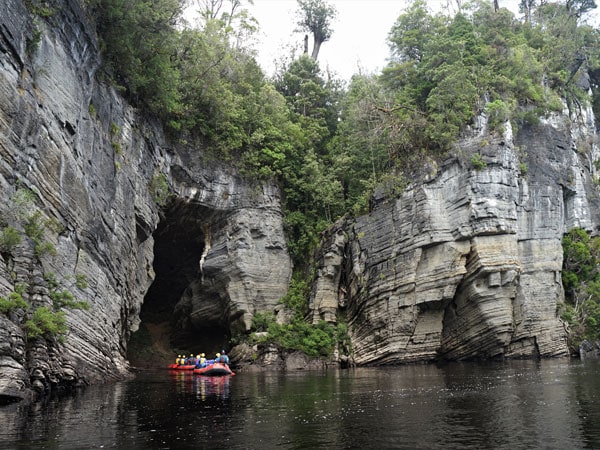
Docking the rafts to explore the Lost World Canyon. (Image: Steve Madgwick)
Downstream, we float past Kutikina Cave mindfully, aware of how sensitive the site is to its Traditional Owners, the palawa. Thousands of bone fragments and stone artefacts were uncovered here in the 1970s, dating Indigenous occupation to at least the last Ice Age. The rediscovery was a crucial cultural element in the area’s World-Heritage trajectory.
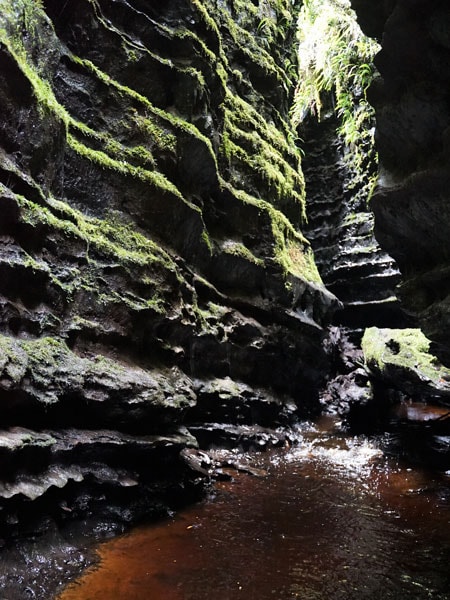
Image: Steve Madgwick
At Pyramid Island, where the Franklin and Gordon merge without fanfare, an azure kingfisher wonders why the hell we can’t stop staring. We ‘truck-and-trailer’ the rafts together to thwart the final-stretch headwind. Thanks to those river-hugging hippies, the once-proposed main dam site is just another stretch of unencumbered river.
Our paddles plop loudly in the stillness while our shoulders and cores whine with the physical realities of an expedition powered only by gravity, water and human oomph. It is not easy being green, as that prolific 1970s Frogwellian philosopher, Kermit, once sang.
Indeed, the Franklin seems to throw test after test at you; sometimes-enveloping chill, ravenous rapids, curious leeches. On days one and two, in its dusky and dawny dispositions, the landscape seemed forebodingly empty, almost in a state of ennui. Every single day since, though, it has unlocked a little bit of itself, which in turn has unlocked a little bit of me.
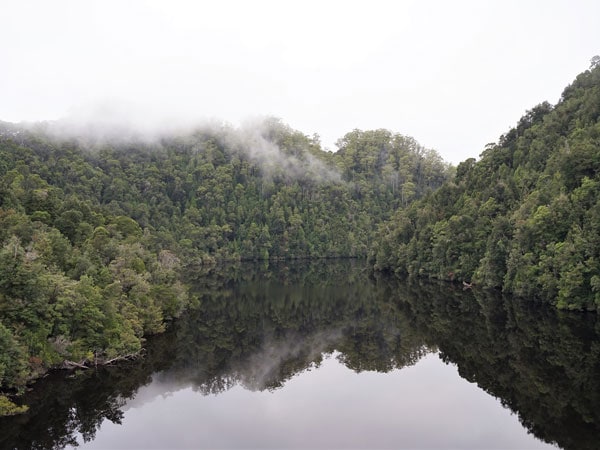
The dark, brooding waters of the Gordon River flow through the Tasmanian Wilderness World Heritage Area. (Image: Steve Madgwick)
I guess this is what happens when you let nature take its true course, tell its own story. As one of the few who have had the privilege to ride this wild river, all I can do is pass on my own version of the Franklin’s indomitable renaissance.
LEAVE YOUR COMMENT